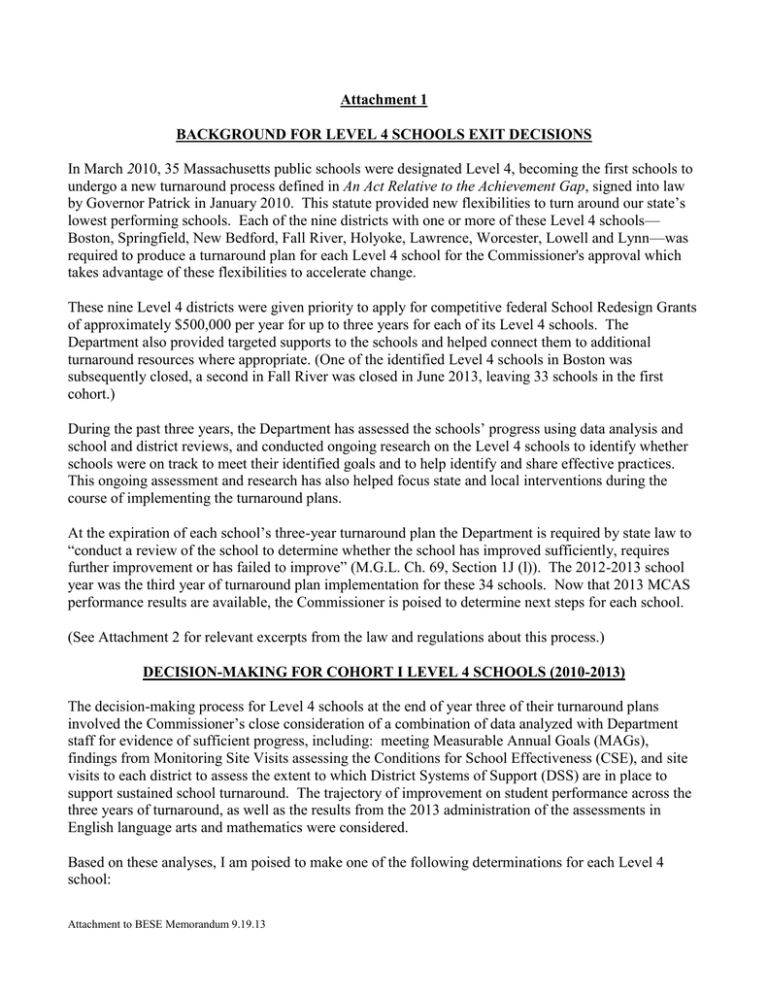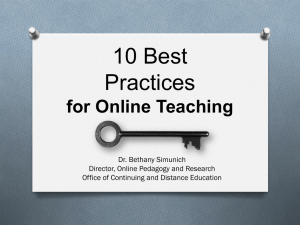spec item1 item2 attach1
advertisement

Attachment 1 BACKGROUND FOR LEVEL 4 SCHOOLS EXIT DECISIONS In March 2010, 35 Massachusetts public schools were designated Level 4, becoming the first schools to undergo a new turnaround process defined in An Act Relative to the Achievement Gap, signed into law by Governor Patrick in January 2010. This statute provided new flexibilities to turn around our state’s lowest performing schools. Each of the nine districts with one or more of these Level 4 schools— Boston, Springfield, New Bedford, Fall River, Holyoke, Lawrence, Worcester, Lowell and Lynn—was required to produce a turnaround plan for each Level 4 school for the Commissioner's approval which takes advantage of these flexibilities to accelerate change. These nine Level 4 districts were given priority to apply for competitive federal School Redesign Grants of approximately $500,000 per year for up to three years for each of its Level 4 schools. The Department also provided targeted supports to the schools and helped connect them to additional turnaround resources where appropriate. (One of the identified Level 4 schools in Boston was subsequently closed, a second in Fall River was closed in June 2013, leaving 33 schools in the first cohort.) During the past three years, the Department has assessed the schools’ progress using data analysis and school and district reviews, and conducted ongoing research on the Level 4 schools to identify whether schools were on track to meet their identified goals and to help identify and share effective practices. This ongoing assessment and research has also helped focus state and local interventions during the course of implementing the turnaround plans. At the expiration of each school’s three-year turnaround plan the Department is required by state law to “conduct a review of the school to determine whether the school has improved sufficiently, requires further improvement or has failed to improve” (M.G.L. Ch. 69, Section 1J (l)). The 2012-2013 school year was the third year of turnaround plan implementation for these 34 schools. Now that 2013 MCAS performance results are available, the Commissioner is poised to determine next steps for each school. (See Attachment 2 for relevant excerpts from the law and regulations about this process.) DECISION-MAKING FOR COHORT I LEVEL 4 SCHOOLS (2010-2013) The decision-making process for Level 4 schools at the end of year three of their turnaround plans involved the Commissioner’s close consideration of a combination of data analyzed with Department staff for evidence of sufficient progress, including: meeting Measurable Annual Goals (MAGs), findings from Monitoring Site Visits assessing the Conditions for School Effectiveness (CSE), and site visits to each district to assess the extent to which District Systems of Support (DSS) are in place to support sustained school turnaround. The trajectory of improvement on student performance across the three years of turnaround, as well as the results from the 2013 administration of the assessments in English language arts and mathematics were considered. Based on these analyses, I am poised to make one of the following determinations for each Level 4 school: Attachment to BESE Memorandum 9.19.13 Option A: School Exits Level 4 (pending the approval of exit assurances) Schools where leaders and staff have implemented strategic and focused turnaround strategies that have enabled the schools to meet their targets and that have enabled students to achieve significant academic progress over the three years, and where district systems are in place to sustain and support ongoing growth, are eligible to exit Level 4 status. The exit of any school from Level 4 to Level 3, 2, or 1 will be contingent on the district’s agreement to a set of assurances designed to help ensure ongoing support and sustained improvements. Option B: School Remains in Level 4 Schools where gains have not been sufficient by the end of their turnaround term are still underperforming and will remain in Level 4. These schools fall into three categories: 1. Schools where one more year of sustained and focused work on turnaround initiatives seems likely to result in meaningful improvements that allow the school to meet their goals. 2. Schools that have made gains, but where indicators suggest that without immediate dramatic and strategic changes to the existing structures and programs, the school is at risk of moving into Level 5 at the end of the 2013-2014 school year. 3. Schools where limited progress in the first two years put them at risk of moving to Level 5 prompted the district to enter into partnerships with state-approved turnaround operators. Option C: School Under Consideration for Level 5 Designation The school has not improved sufficiently and needs to be considered for a Level 5 (“chronically underperforming”) designation to ensure that needed dramatic turnaround will take place. However, before the Commissioner makes such a designation, our regulations indicate that he must hear from members of the school community, including school, district, and municipal officials; members of the school committee; representatives from the local teachers’ union, a representative from the school’s parent organization, and family members of students at the school. Schools under consideration for Level 5 designation can expect that in October 2013, the Commissioner will be convening meetings in their communities with the persons identified above. After these conversations the Commissioner will make his final determination about Level 5 designation. Attachment to BESE Memorandum 9.19.13



